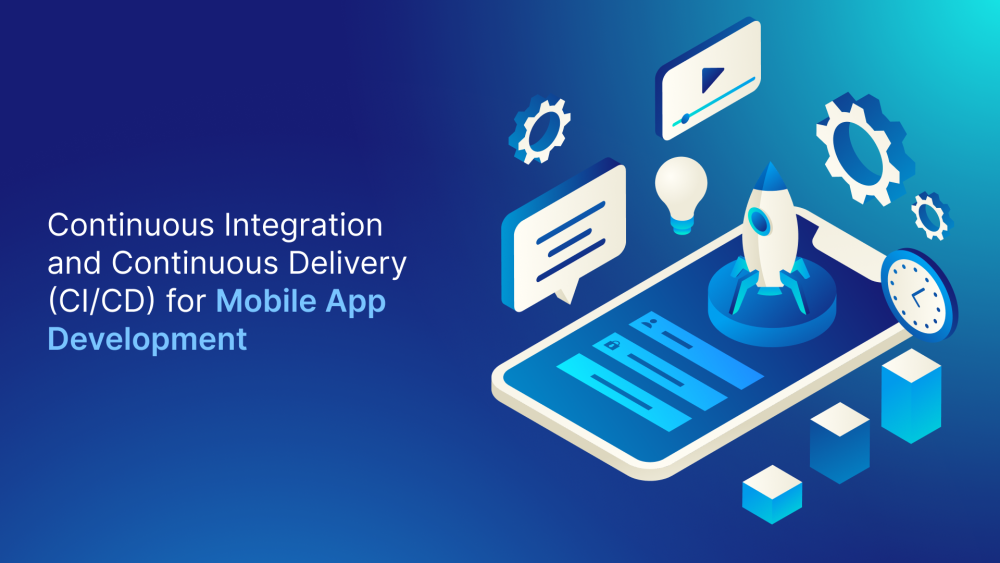The rapid pace of mobile app development necessitates efficient and reliable software delivery pipelines. Continuous Integration and Continuous Delivery (CI/CD) have emerged as essential practices for automating the build, test, and deployment processes, ensuring faster time-to-market and improved software quality. This blog delves into the intricacies of implementing CI/CD for mobile app development, exploring its benefits, challenges, and best practices.
Understanding CI/CD for Mobile App Development
CI/CD is a software development methodology that promotes continuous integration and delivery of applications. In the context of mobile app development, it involves automating the build, testing, and deployment processes to accelerate development cycles and reduce errors.
Key components of CI/CD for mobile apps:
-
Version Control: Maintaining codebase history and enabling collaboration through tools like Git.
-
Build Automation: Automating the compilation of app code into build artifacts.
-
Testing: Executing unit, integration, and UI tests to ensure code quality.
-
Deployment: Automating the distribution of the app to various app stores or internal distribution channels.
By implementing a robust CI/CD pipeline, development teams can achieve faster feedback loops, improved code quality, and increased deployment frequency.
.png)
Benefits of CI/CD for Mobile App Development
-
Faster Time-to-Market: Automated processes reduce manual intervention and accelerate the release cycle.
-
Improved Quality: Frequent testing and integration catch defects early in the development process.
-
Increased Deployment Frequency: Enables more frequent releases with smaller, incremental changes.
-
Enhanced Collaboration: Facilitates teamwork and promotes code sharing through version control.
-
Reduced Human Error: Automation minimizes the risk of errors caused by manual processes.
A study by Puppet Labs found that high-performing IT organizations deploy code 200 times more frequently than low-performing ones, emphasizing the importance of CI/CD.
Building a CI/CD Pipeline for Mobile Apps
A typical CI/CD pipeline for mobile app development involves the following stages:
-
Code Commit: Developers commit code changes to a shared version control repository.
-
Build Trigger: The CI server is triggered to build the app based on the code changes.
-
Testing: Automated unit, integration, and UI tests are executed.
-
Code Signing: The app is signed with appropriate certificates for distribution.
-
Deployment: The built app is deployed to app stores or internal distribution channels.
Tools and Technologies:
-
Version Control: Git, SVN
-
CI/CD Servers: Jenkins, CircleCI, GitLab CI/CD, Bitrise
-
Build Tools: Gradle (Android), Xcode (iOS)
-
Testing Frameworks: XCTest (iOS), Espresso (Android), Appium
-
Code Signing Tools: Keystores, provisioning profiles
By integrating these tools, organizations can establish efficient and reliable CI/CD pipelines.
Challenges and Considerations
Implementing CI/CD for mobile app development presents certain challenges:
-
Complex Build Processes: Mobile app builds often involve multiple steps and dependencies.
-
Testing Environments: Maintaining consistent testing environments can be complex.
-
Deployment Challenges: App store submission processes and review times can introduce delays.
-
Security: Protecting sensitive app information and code is crucial.
To address these challenges, organizations should adopt best practices, utilize appropriate tools, and invest in continuous improvement.
Advanced CI/CD Practices for Mobile Apps
To optimize the CI/CD process for mobile app development, consider the following advanced techniques:
-
Continuous Testing: Implement comprehensive test automation, including unit, integration, UI, and performance tests.
-
Canary Deployments: Gradually release new app versions to a subset of users to monitor performance and gather feedback.
-
Feature Flags: Enable dynamic feature toggling to control feature visibility without redeploying the app.
-
Mobile DevOps: Combine CI/CD with DevOps practices for end-to-end application lifecycle management.
-
Mobile Analytics Integration: Integrate with analytics tools to gather app usage data and inform future development.
By incorporating these practices, organizations can achieve even greater efficiency and quality in their mobile app development process.
Conclusion
CI/CD is a cornerstone of modern mobile app development, enabling faster time-to-market, improved quality, and increased developer productivity. By understanding the core principles, leveraging appropriate tools, and addressing potential challenges, organizations can build robust and efficient CI/CD pipelines. As the mobile app landscape continues to evolve, embracing CI/CD will be essential for staying competitive and delivering exceptional user experiences.
Remember, a well-structured CI/CD pipeline is an ongoing investment that requires continuous improvement and adaptation to evolving technologies and business needs.


